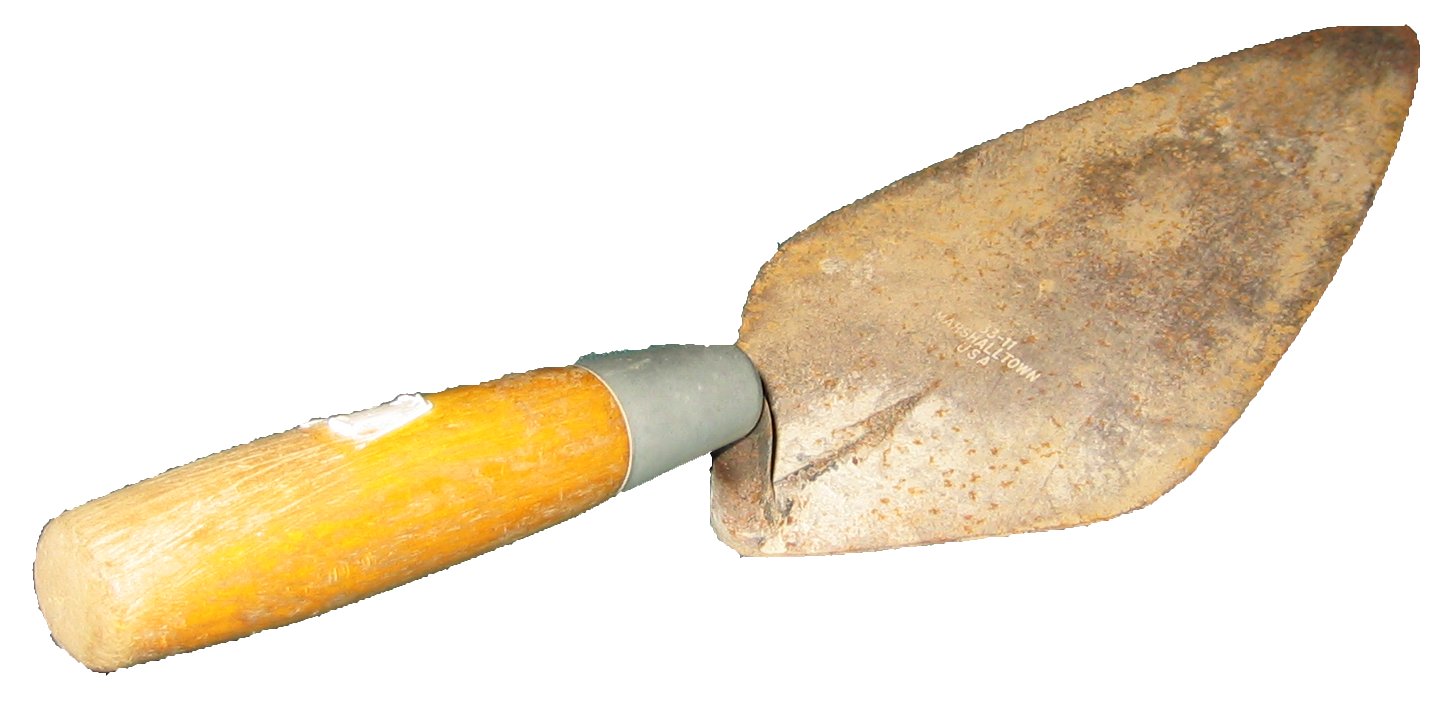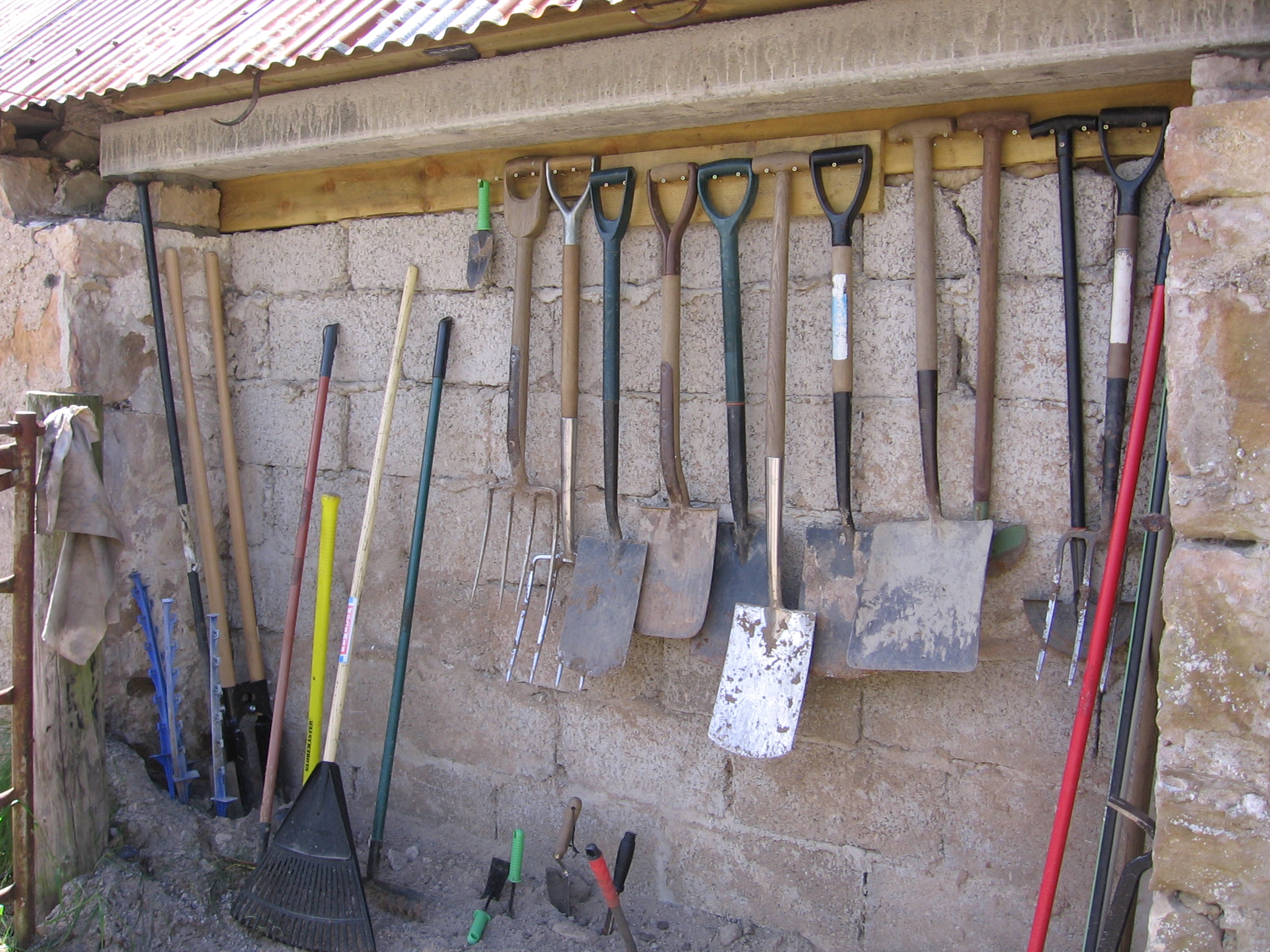|
Khurpa
A khurpa is a short handled cutting tool similar to a Trowel with a flat blade used for digging soil and weeding in small gardens or vegetable farms. It is commonly use in small farms or in ridges or rows of vegetables to hoewing or earth up the weeds. It is traditionally used while in a squatting posture. The work khurpa is word of Punjabi language. It is in Punjab Punjab (; Punjabi: پنجاب ; ਪੰਜਾਬ ; ; also romanised as ''Panjāb'' or ''Panj-Āb'') is a geopolitical, cultural, and historical region in South Asia, specifically in the northern part of the Indian subcontinent, comprising ... and other areas in India for various processes like tilling, bed preparation, weeding and digging at small scale. References {{reflist Gardening tools Mechanical hand tools Squatting position ... [...More Info...] [...Related Items...] OR: [Wikipedia] [Google] [Baidu] |
Trowel
A trowel is a small hand tool used for digging, applying, smoothing, or moving small amounts of viscous or particulate material. Common varieties include the masonry trowel, garden trowel, and float trowel. A power trowel is a much larger gasoline or electrically powered walk-behind device with rotating paddles used to finish concrete floors. Hand tool Numerous forms of trowel are used in masonry, concrete, and drywall construction, as well as applying adhesives such as those used in tiling and laying synthetic flooring. Masonry trowels are traditionally made of forged carbon steel, but some newer versions are made of cast stainless steel, which has longer wear and is rust-free. These include: *Bricklayer's trowel has an elongated triangular-shaped flat metal blade, used by masons for leveling, spreading, and shaping cement, plaster, and mortar. *Pointing trowel, a scaled-down version of a bricklayer's trowel, for small jobs and repair work. *Tuck pointing trowel is lo ... [...More Info...] [...Related Items...] OR: [Wikipedia] [Google] [Baidu] |
Weeding
Weed control is a type of pest control, which attempts to stop or reduce growth of weeds, especially noxious weeds, with the aim of reducing their competition with desired flora and fauna including domesticated plants and livestock, and in natural settings preventing non native species competing with native species. Weed control is important in agriculture. Methods include hand cultivation with hoes, powered cultivation with cultivators, smothering with mulch, lethal wilting with high heat, burning, and chemical control with herbicides (weed killers). Need for control Weeds compete with productive crops or pasture, they can be poisonous, distasteful, produce burrs, thorns or otherwise interfere with the use and management of desirable plants by contaminating harvests or interfering with livestock. Weeds compete with crops for space, nutrients, water and light. Smaller, slower growing seedlings are more susceptible than those that are larger and more vigorous. Onions are one ... [...More Info...] [...Related Items...] OR: [Wikipedia] [Google] [Baidu] |
Hoeing
A hoe is an ancient and versatile agricultural and horticultural hand tool used to shape soil, remove weeds, clear soil, and harvest root crops. Shaping the soil includes piling soil around the base of plants (hilling), digging narrow furrows ( drills) and shallow trenches for planting seeds or bulbs. Weeding with a hoe includes agitating the surface of the soil or cutting foliage from roots, and clearing the soil of old roots and crop residues. Hoes for digging and moving soil are used to harvest root crops such as potatoes. Types There are many kinds of hoes of varied appearances and purposes. Some offer multiple functions while others have only a singular and specific purpose. There are two general types of hoe: draw hoes for shaping soil and scuffle hoes for weeding and aerating soil. A draw hoe has a blade set at approximately a right angle to the shaft. The user chops into the ground and then pulls (draws) the blade towards them. Altering the angle of the handle ... [...More Info...] [...Related Items...] OR: [Wikipedia] [Google] [Baidu] |
Squatting Posture
Squatting is a versatile posture where the weight of the body is on the feet but the knees and hips are bent. In contrast, sitting involves taking the weight of the body, at least in part, on the buttocks against the ground or a horizontal object. The angle between the legs when squatting can vary from zero to widely splayed out, flexibility permitting. Another variable may be the degree of forward tilt of the upper body from the hips. Squatting may be either full or partial. Crouching is usually considered to be synonymous with squatting. It is common to squat with one leg and kneel with the other leg. One or both heels may be up when squatting. Young children often instinctively squat. Among Chinese, Southeast Asian and Eastern European adults, squatting often takes the place of sitting or standing. Etymology Squatting comes from the Old French ''esquatir/escatir'', meaning to "compress/press down". The weight-lifting sense of squatting is from 1954.Harper, D. (n.d.). Etymol ... [...More Info...] [...Related Items...] OR: [Wikipedia] [Google] [Baidu] |
Punjabi Language
Punjabi (; ; , ), sometimes spelled Panjabi, is an Indo-Aryan language of the Punjab region of Pakistan and India. It has approximately 113 million native speakers. Punjabi is the most widely-spoken first language in Pakistan, with 80.5 million native speakers as per the 2017 census, and the 11th most widely-spoken in India, with 31.1 million native speakers, as per the 2011 census. The language is spoken among a significant overseas diaspora, particularly in Canada, the United States, and the United Kingdom. In Pakistan, Punjabi is written using the Shahmukhi alphabet, based on the Perso-Arabic script; in India, it is written using the Gurmukhi alphabet, based on the Indic scripts. Punjabi is unusual among the Indo-Aryan languages and the broader Indo-European language family in its usage of lexical tone. History Etymology The word ''Punjabi'' (sometimes spelled ''Panjabi'') has been derived from the word ''Panj-āb'', Persian for 'Five Waters', referring to the ... [...More Info...] [...Related Items...] OR: [Wikipedia] [Google] [Baidu] |
Punjab, India
Punjab (; ) is a States and union territories of India, state in northern India. Forming part of the larger Punjab region of the Indian subcontinent, the state is bordered by the States and union territories of India, Indian states of Himachal Pradesh to the north and northeast, Haryana to the south and southeast, and Rajasthan to the southwest; by the Indian union territory, union territories of Chandigarh to the east and Jammu and Kashmir (union territory), Jammu and Kashmir to the north. It shares an international border with Punjab, Pakistan, Punjab, a Pakistani province, province of Pakistan to the west. The state covers an area of 50,362 square kilometres (19,445 square miles), which is 1.53% of India's total geographical area, making it List of states and union territories of India by area, the 19th-largest Indian state by area out of 28 Indian states (20th largest, if UTs are considered). With over 27 million inhabitants, Punjab is List of states and union territories of ... [...More Info...] [...Related Items...] OR: [Wikipedia] [Google] [Baidu] |
Gardening Tools
A garden tool is any one of many tools made for gardening and landscaping, which overlap with the range of tools made for agriculture and horticulture. Garden tools can be divided into hand tools and power tools. Hand tools Today's garden tools originated with the earliest agricultural implements used by humans. Examples include the hatchet, axe, sickle, scythe, pitchfork, spade, shovel, trowel, hoe, fork, and rake. In some places, the machete is common. The earliest tools were made variously of wood, flint, metal, tin, and bone. The development of metalworking, first in copper and later in bronze, iron, and steel, produced today's durable tools, including such efficient cutting tools as pruning shears (secateurs – for example anvil pruners), grass shears, and loppers. Increasing use of modern alloys allows many tools to be made both stronger and lighter, making them more durable and easier to use. Ergonomics Some modern tool designs reflect ergonomic considerations, be ... [...More Info...] [...Related Items...] OR: [Wikipedia] [Google] [Baidu] |
Mechanical Hand Tools
Mechanical may refer to: Machine * Machine (mechanical), a system of mechanisms that shape the actuator input to achieve a specific application of output forces and movement * Mechanical calculator, a device used to perform the basic operations of arithmetic * Mechanical energy, the sum of potential energy and kinetic energy * Mechanical system, a system that manages the power of forces and movements to accomplish a task * Mechanism (engineering), a portion of a mechanical device Other * Mechanical (character), one of several characters in Shakespeare's ''A Midsummer Night's Dream'' * A kind of typeface in the VOX-ATypI classification See also * Machine, especially in opposition to an electronic item * ''Mechanical Animals'', the third full-length studio release by Marilyn Manson * Manufactured or artificial, especially in opposition to a biological or natural component * Automation, using machine decisions and processing instead of human * Mechanization, using machine labor inste ... [...More Info...] [...Related Items...] OR: [Wikipedia] [Google] [Baidu] |




